
This post originally appeared on Fast Data Science’s blog on LinkedIn.
Formulating a robust research question is the foundation of any successful clinical research study. This fundamental step shapes the entire project’s direction, feasibility, and impact. Let’s explore the essential aspects of crafting an effective research question.
The best research questions for seasoned investigators often stem from their prior studies or field observations. However, new investigators, although lacking extensive experience, can bring fresh perspectives that might lead to innovative approaches. It’s crucial to differentiate between a research interest and a research question. For instance, the question, “Does providing a regular basic income reduce depression among middle-aged adults?” arises from a broader interest in social determinants of health.
To identify a compelling research question:
Reflect on studies that have piqued your interest.
Consider clinical scenarios where patient outcomes could have been improved.
Question current practices and their effectiveness.
A substantial research question should be Feasible, Important, Novel, and Ethical (FINE):
Feasible: Ensure the study can be practically conducted with available resources, including sufficient participants.
Important: The question should address a significant issue that can impact patient care or advance scientific knowledge.
Novel: It should contribute new insights or challenge existing paradigms.
Ethical: The study must respect ethical standards and obtain necessary approvals.
Becoming an expert in your chosen area is fundamental. Conduct thorough literature reviews and stay updated with recent advances by:
Attending scientific meetings.
Engaging with experts and following thought leaders.
Utilizing resources like ClinicalTrials.gov and Prospero for ongoing research and systematic reviews.
Research ideas can emerge from various sources:
Clinical experiences and observations.
Collaborations with other investigators.
Teaching and discussions with students.
Informal conversations at conferences.
Creativity plays a vital role in this process. Embrace new technologies and methodologies to generate innovative research questions.
The journey from identifying a research interest to formulating a feasible research question requires careful consideration, thorough research, and creativity. By focusing on the FINE characteristics and continuously building your expertise, you can develop impactful research questions that pave the way for meaningful and valid studies.
Enhance your clinical research with precise cost and risk estimates using our Clinical Trial Risk Tool. This AI-powered tool analyzes clinical documents to provide actionable insights, helping you make informed decisions. Try the Clinical Trial Risk Tool today!
Source:
Browner, Warren, S. et al. Designing Clinical Research. Available from: Wolters Kluwer, (5th Edition). Wolters Kluwer Health, 2022.
#ClinicalResearch #ResearchMethodology #HealthcareInnovation #ScientificInquiry

Thomas Wood presents the Clinical Trial Risk Tool at the Clinical AI Interest Group at Alan Turing Institute The Clinical AI Interest group is a community of health professionals from a broad range of backgrounds with an interest in Clinical AI, organised by the Alan Turing Institute. In the group’s November 2025 meeting, the talk was given by Dr Jeff Hogg, Programme Director, MSc AI Implementation (Healthcare), University of Birmingham and Clinical Innovation Officer in AI, University Hospitals Birmingham NHSFT, titled AI Readiness for Health and Care Provider Organisations.

Guest post by Safeer Khan, Lecturer at Department of Pharmaceutical Sciences, Government College University, Lahore, Pakistan Multi-Arm & Multi-Stage (MAMS) Clinical Trials Design Tips The design of clinical trials is increasingly challenged by the Rising Costs, limited availability of eligible patient populations, and the growing demand for timely therapeutic evaluation. Traditional parallel-group designs, which typically compare a single intervention to a control, are often insufficient to meet these pressures in terms of speed, efficiency, and resource utilization.

You can use the t-test when you want to compare the means (averages) of continuous data between two groups, such as blood pressure or maximum concentration of a drug in urine (Cmax). If you have data with a dichotomous outcome, you can use the Chi-Squared test instead - please try our Chi-Squared sample size calculator. The calculator below will calculate the minimum sample size for you. Your expected effect size d is the standardised effect size according to Cohen’s definition.